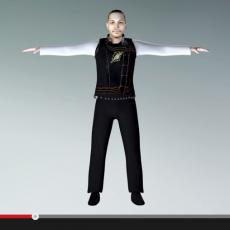Overview
 The clothing of men in Roumlouki, as is the case in most similar in the entire country, devoid of luxury women and is characterized by its simplicity, austerity, rigor, with a restriction in bold décor and of course the use of almost completely local materials for weaving.
The clothing of men in Roumlouki, as is the case in most similar in the entire country, devoid of luxury women and is characterized by its simplicity, austerity, rigor, with a restriction in bold décor and of course the use of almost completely local materials for weaving.
The male outfit of Roumlouki as established in the last pre-World War II decades, consists of the following items : katastari (next to the skin), that is thick woolen jersey which is made in the loom or knit with needles in hand, cotton shirt with collar and buttons until the height of the umbilical cord, in white color for young and black color for older, breasted black vest without sleeves or with sleeves that called “meitani” and in winter thicker, the “doulama” with unique decorations black braids and small embroidery in small pocket, which was at heart level, baggy pants, the “boulmpotsa”, while younger wore the zivro, that is trousers of the same material more closely and coinciding with the leg below the knee and after the Second World War known as “panties”. Previously, wore the ordinary throughout the Ottoman Empire, the “benevrekia” and the “salvaria”. On the feet were black woolen socks, hand knitted with “kloutses” (kaltsovelones),the “skoufounia”, and in winter wrapped tightly until the calf the “bigialia” (type of ghetto), a white cloth made in loom, as everyday footwear the “gourounotsaroucha” and in official appearances leather shoes from Veria or slippers as named the leather boots. In some villages, such as Schinia, the “boulmpotses” made of flax or hemp, which the villagers grew massively in their properties or estates of the beys.
Their coats sewn from thick black cloth, which were lined with skins of sheep, known as “patatoukes”, or “tserketes” and “kapotia”, while shepherds wore capes of wool goat sleeves and hood, which were bought from Veria or adjacent Roumlouki villages of Pieria and the “koukliata”, a kind of coats until the hips of siargkavo (gray color) wool, that they used from the residents of village Loutros.
As head cover used, summer straw hats, the “Skiathes” who wove and sewed themselves with ears of rye, and the winter knitted wool black hats or hats from black fabric as dikocha who called Sapkas.
Previously, however, until the early 1920s , the residents of Roumlouki have their formal dress kilt, the “tsoliadistiki” costume as it was called, consisted of a woolen jersey, the white short with many folds (lagkolia) kilt, the white shirt with the sleeves, the black sleeveless double-breasted vest, in winter the doulama sleeveless, the baggy white pants from denim, the big baggy black belts, the “skoufounia”, the “gourounotsaroucha” and headband knit cap or sapka. The outfit was gradually abandoned and replaced until the early 1920s from the practical and usable boulmpotses. For a long time the outfit worn at weddings from the groom, best man and close friends and of course the dancers who were the mob to commit the custom of Rougkatsion, who in recent decades wear as a headband the “fesi”, without tassel and with a small cross embroidered on the front part.